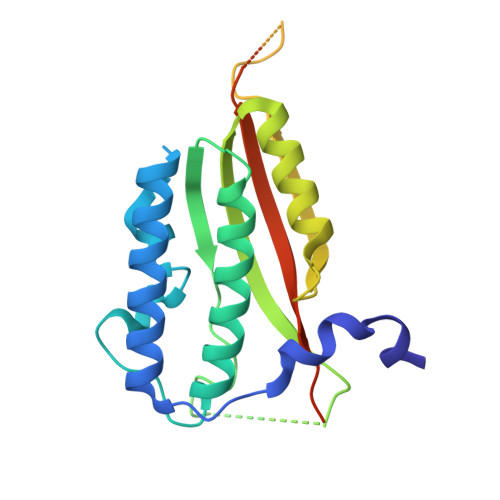The variable oligomeric state of Amuc_1100 from Akkermansia muciniphila.
Wang, J., Xiang, R., Wang, R., Zhang, B., Gong, W., Zhang, J., Zhang, M., Wang, M.(2020) J Struct Biol 212: 107593-107593
- PubMed: 32736072
- DOI: https://doi.org/10.1016/j.jsb.2020.107593
- Primary Citation of Related Structures:
6LAD, 6LAF - PubMed Abstract:
Akkermansia muciniphila is a beneficial microorganism colonized in the human gut that can reverse many intestinal metabolic-related diseases. Amuc_1100 is an outer-membrane protein of A. muciniphila. Oral administration of Amuc_1100 can reduce fat mass development, insulin resistance, and dyslipidemia in mice and activated the toll-like receptor 2 (TLR2) to regulate the immune response of the host, but the molecular mechanism remains unclear. Here we report the crystal structure of the extramembranous domain of Amuc_1100, which consists of a four-stranded antiparallel β-sheet and four α-helices. Two C-terminal helices and the four-stranded antiparallel β-sheet formed two "αββ" motifs and constituted the core domain, which shared a similar fold with type IV pili and type II Secretion system protein. Although the full-length of the extramembranous domain of Amuc_1100 existed as a monomer in solution, they formed trimer in the crystal. Elimination of the N-terminal coiled-coil helix α1 led to dimerization of Amuc_1100 both in solution and in crystal, indicating that the oligomeric state of Amuc_1100 was variable and could be influenced by α1. In addition, we identified that Amuc_1100 could directly bind human TLR2 (hTRL2) in vitro, suggesting that Amuc_1100 may serve as a new ligand for hTLR2. Dimerization of Amuc_1100 improved its hTLR2-binding affinity, suggesting that the α1-truncated Amuc_1100 could be a beneficial candidate for the development of A. muciniphila related drugs.
Organizational Affiliation:
School of Life Sciences, Anhui University, Hefei 230601, Anhui, China; Institutes of Physical Science and Information Technology, Anhui University, Hefei 230601, Anhui, China; Key Laboratory of Human Microenvironment and Precision Medicine of Anhui Higher Education Institutes, Anhui University, Hefei 230601, Anhui, China.















